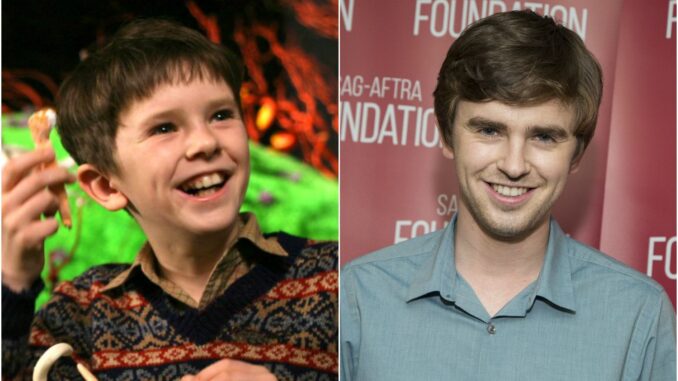
When Tim Burton’s “Charlie and the Chocolate Factory” premiered in 2005, it entered a cultural landscape already deeply shaped by Mel Stuart’s beloved 1971 adaptation “Willy Wonka & the Chocolate Factory,” starring Gene Wilder. At the heart of Burton’s reimagining stood Freddie Highmore as Charlie Bucket, tasked with creating a version of Roald Dahl’s most virtuous child hero that could stand independently from Peter Ostrum’s earlier portrayal. The contrast between these two Charlies—separated by decades, directorial visions, and evolving understandings of childhood—offers fascinating insight into how children’s literature adaptations have evolved and how Highmore’s particular talents contributed to a more complex, psychologically nuanced vision of Dahl’s world.
The differences between the adaptations begin with their fundamental approaches to Dahl’s source material. Stuart’s 1971 film, while cherished by generations of viewers, took significant liberties with Dahl’s novel, expanding the Wonka character and adding musical numbers that transformed the story into a whimsical musical fantasy. Burton’s version explicitly positioned itself as a more faithful adaptation of Dahl’s darker, more sardonic vision. This context shaped both Ostrum’s and Highmore’s interpretations of Charlie—the former playing a character softened somewhat from Dahl’s original, the latter inhabiting a vision of childhood more aligned with the author’s unsentimental perspective.
Peter Ostrum’s Charlie embodies mid-20th century American ideals of childhood innocence—earnest, wide-eyed, and unambiguously good-hearted. His performance employs the naturalistic style typical of child actors in family films of that era, prioritizing likability and clear emotional expression over psychological complexity. Highmore’s Charlie, by contrast, carries the weight of early 21st century understanding of childhood hardship. Living in extreme poverty with his family, this Charlie exhibits a quiet resilience and premature responsibility that feels more psychologically authentic to a child in his circumstances.
“I was interested in the strength Charlie has,” Highmore explained in interviews promoting the film. “He has every reason to be bitter or angry about his situation, but instead he finds joy and remains generous. That’s not simple goodness—that’s a choice he makes every day.” This approach allowed Highmore to portray Charlie’s virtue not as inherent innocence but as active moral character developed in response to hardship—a more complex and contemporary understanding of childhood resilience.
Visually, the two portrayals reflect their films’ distinct aesthetics. Ostrum’s Charlie exists in a world of warm, golden-hued nostalgia—a timeless small-town Americana that, even in its depiction of poverty, retains a certain coziness. Highmore’s Charlie inhabits Burton’s signature gothic-industrial landscape, where extreme poverty is rendered in desaturated blues and grays that more explicitly visualize economic hardship. His performance matches this visual context—more contained, watchful, and guarded than Ostrum’s open-faced enthusiasm.
The relationships between Charlie and Wonka differ dramatically between the adaptations as well. In the 1971 film, Wilder’s Wonka tests Charlie’s moral character, with their relationship developing into a surrogate father-son dynamic that culminates in Charlie’s inheritance of the factory. Burton’s version, influenced by early 2000s interest in psychological backstory, creates a parallel between Charlie’s healthy family relationships and Wonka’s traumatic childhood with his dentist father. This required Highmore to portray not just Charlie’s goodness but his emotional intelligence—his understanding of Wonka’s psychological wounds and his role in helping heal them.
This shift reflects broader changes in how children’s literature adaptations approach child characters. Films of the 1970s often presented children as symbols of uncomplicated virtue or innocence. Contemporary adaptations, influenced by developments in child psychology and changing social attitudes, increasingly present children as complex individuals with inner lives as rich and contradictory as those of adults. Highmore’s performance exemplifies this evolution, bringing psychological depth to a character that could easily have become a one-dimensional emblem of virtue.
